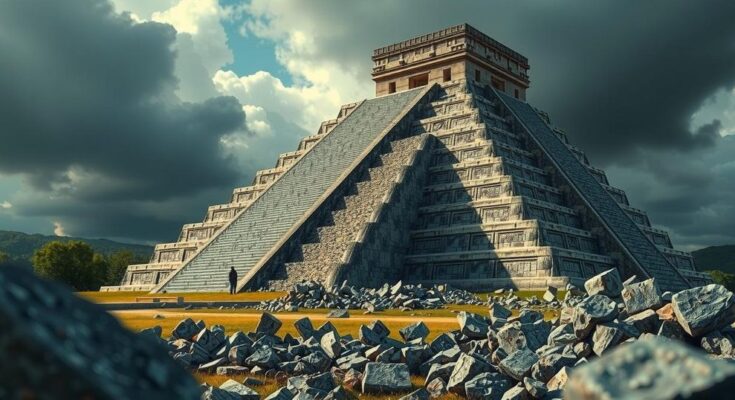In July 2024, a historic pyramid in Ihuatzio, Mexico, collapsed due to extreme weather, following a severe drought. The event highlights the vulnerabilities of cultural heritage sites to climate change, prompting efforts for restoration while raising broader concerns about the ongoing impact of such environmental changes on significant archaeological landmarks worldwide.
In a poignant illustration of the adverse effects of climate change, a historic stone pyramid in Mexico collapsed on July 29, 2024. This 15-meter-high monument, located in Ihuatzio, Michoacán, suffered catastrophic degradation due to unprecedented rainfall following a prolonged drought. The structure, once a symbol of the stark architectural prowess of the P’urhépechas civilization, was deemed crucial to the cultural heritage of Mexico, which is now facing the grim realities of climate variability. The archaeological site of Ihuatzio is home to significant relics of the Michoacán Kingdom. The pyramid endured as one of the best-preserved structures, highlighting the region’s rich history, including its indigenous Nahuatl-speaking inhabitants and the resilient P’urhépechas, who famously resisted Aztec conquests. Unfortunately, extreme weather events exacerbated by climate change have left this site vulnerable, prompting concerns among preservationists and historians alike. The National Institute of Anthropology and History (INAH) reported that while only one pyramid was affected by the recent disaster, several other structures showed signs of deterioration. Heavy rains followed by storms led to the deterioration of the pyramid’s outer wall and inner structures. “The high temperatures, previously recorded in the area, and the consequent drought caused cracks that favored the filtration of water into the interior of the pre-Hispanic building,” stated an INAH representative. In light of these events, INAH has initiated efforts aimed at restoration to safeguard this vital cultural site. Moreover, such occurrences underscore a broader trend in which climate change threatens archaeological sites worldwide. Recent studies indicate not only the degradation of structures in Mexico but also the deterioration of ancient cave paintings across Oceania due to similar environmental stresses.
The collapse of the pyramid at Ihuatzio is a stark reminder of the intersection of human history and environmental integrity. Many of the world’s heritage sites are now at risk from increasing extreme weather events linked to climate change. For centuries, these sites have been reservoirs of cultural and historical significance, representing the achievements and resilience of past civilizations. Current climate patterns, including fluctuating precipitation and unprecedented drought conditions, are reshaping landscapes once considered stable, leading to alarming deterioration of these invaluable artifacts.
In summary, the demise of the pyramid in Mexico is not merely a local tragedy but a reflection of a global crisis impacting cultural heritage sites throughout the world. As climate change continues to evolve, it is imperative to understand the implications for our shared history and take action to preserve these vital cultural markers. The incident serves as a profound call to action for preservationists and policymakers to address the underlying causes and protect our irreplaceable legacy for future generations.
Original Source: www.sciencealert.com




